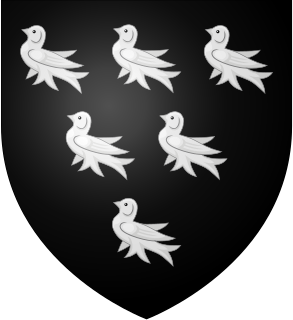 W
WSir John Arundell (1495–1561), of Trerice, Cornwall, nicknamed "Tilbury Jack", was a commander of the Royal Navy during the reigns of Kings Henry VIII and Edward VI and served twice as Sheriff of Cornwall.
 W
WJohn Russell, 1st Earl of Bedford was an English royal minister in the Tudor era. He served variously as Lord High Admiral and Lord Privy Seal. Among the lands and property he was given by Henry VIII after the Dissolution of the Monasteries, were the Abbey and town of Tavistock, and the area that is now Covent Garden. Russell is the ancestor of all subsequent Earls and Dukes of Bedford and Earls Russell, including John Russell, Prime Minister of the United Kingdom and philosopher Bertrand Russell.
 W
WSir George Beeston or Beston was an English landowner, courtier, soldier and sailor. He was the captain of the Dreadnought in 1588, Member of Parliament for Cheshire in 1589 and Ranger of Delamere Forest.
 W
WFulke Greville, 1st Baron Brooke, de jure 13th Baron Latimer and 5th Baron Willoughby de Broke KB PC, known before 1621 as Sir Fulke Greville, was an Elizabethan poet, dramatist, and statesman who sat in the House of Commons at various times between 1581 and 1621, when he was raised to the peerage.
 W
WVice-Admiral, Sir George Carew was an English soldier, admiral and adventurer during the reign of King Henry VIII who died in the sinking of the Royal Navy flagship Mary Rose at the Battle of the Solent during an attempted French invasion in the Italian War of 1542–1546. Scion of a controversial and dramatic family, Carew had a wild youth and explored widely, being arrested several times for associating with rebellious vassals of the king. Carew successfully tamed this nature in his later years, during which he became a trusted advisor and military officer in the King's service.
 W
WSir George Clifford, 3rd Earl of Cumberland, 13th Baron de Clifford, 13th Lord of Skipton, KG, was an English peer, naval commander, and courtier of Queen Elizabeth I of England. He was notable at court for his jousting, at the Accession Day Tilts, which were highlights of the year at court. Two famous survivals, his portrait miniature by Nicholas Hilliard and a garniture of Greenwich armour, reflect this important part of his life. In contrast, he neglected his estates in the far north of England, and left a long succession dispute between his heirs.
 W
WSir Francis Drake was an English sea captain, privateer, naval officer, and explorer. Drake is best known for his circumnavigation of the world in a single expedition, from 1577 to 1580. This included his incursion into the Pacific Ocean, until then an area of exclusive Spanish interest, and his claim to New Albion for England, an area in what is now the American state of California. His expedition inaugurated an era of conflict with the Spanish on the western coast of the Americas, an area that had previously been largely unexplored by Western shipping.
 W
WSir Martin Frobisher was an English seaman and privateer who made three voyages to the New World looking for the North-west Passage. He probably sighted Resolution Island near Labrador in north-eastern Canada, before entering Frobisher Bay and landing on present-day Baffin Island. On his second voyage, Frobisher found what he thought was gold ore and carried 200 tons of it home on three ships, where initial assaying determined it to be worth a profit of £5.20 per ton. Encouraged, Frobisher returned to Canada with an even larger fleet and dug several mines around Frobisher Bay. He carried 1,350 tons of the ore back to England, where, after years of smelting, it was realised that the ore was a worthless rock called hornblende. As an English privateer, he plundered riches from French ships. He was later knighted for his service in repelling the Spanish Armada in 1588.
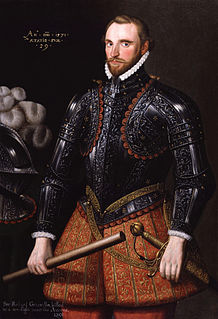 W
WSir Richard Grenville, also spelt Greynvile, Greeneville, and Greenfield, was an English sailor who, as captain of Revenge, died at the Battle of Flores (1591), fighting against overwhelming odds, and refusing to surrender his ship to the far more numerous Spanish. His ship, Revenge, met 53 Spanish warships near Flores in the Azores. He and his crew fought the fifty three in a three-day running battle. Many Spanish ships were sunk or so badly damaged that they had to retire from the battle. Revenge was boarded three times and each time the boarders were seen off.
 W
WSir John Hawkins was a pioneering English naval commander and administrator. He was also a privateer and an early promoter of English involvement in the Atlantic slave trade.
 W
WWilliam Howard, 1st Baron Howard of Effingham was the son of Thomas Howard, 2nd Duke of Norfolk and Agnes Tilney. He served four monarchs, Henry VIII, Edward VI, Mary I and Elizabeth I, in various official capacities, most notably on diplomatic missions and as Lord Admiral and Lord Chamberlain of the Household.
 W
WSir Edward Howard, KG was an English naval officer. He was the first of the Howards to win fame as an admiral, participating in his first naval battle while in his teens. He was in command during the Battle of Saint-Mathieu, which may have been the first sea battle fought by ships with cannons deployed through ports. He was killed shortly afterwards, leading an assault on galleys in the French fleet near Brest.
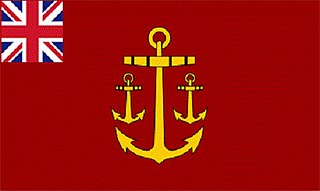 W
WThe Keeper of the Storehouses and formally known as the Keeper of the King's Storehouses was an English Navy appointment created in 1524 the office holder was a principal member of the Council of the Marine from 1546 until the post was abolished and his duties assumed by the Treasurer of the Navy in 1560. He was responsible for the storing and supply of naval stores at naval dockyards for the navy.
 W
WSir Richard Leveson was an important Elizabethan Navy officer, politician and landowner. His origins were in the landed gentry of Shropshire and Staffordshire. A client and son-in-law of Charles Howard, 1st Earl of Nottingham, he became Vice-Admiral under him. He served twice as MP for Shropshire in the English parliament. He was ruined by the burden of debt built up by his father.
 W
WThe Lieutenant of the Admiralty is a now honorary office generally held by a senior retired Royal Navy admiral. He is the official deputy to the Lord High Admiral, an office vested in Prince Philip, Duke of Edinburgh since 2011. He is appointed by the Sovereign on the nomination of the First Sea Lord.
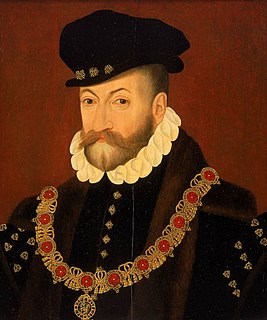 W
WEdward Fiennes, or Clinton, 1st Earl of Lincoln KG was an English landowner, peer, and Lord High Admiral. He rendered valuable service to four of the Tudor monarchs.
 W
WThe Lord High Admiral is the titular head of the Royal Navy. Most have been courtiers or members of the Royal Family, and not professional naval officers. The office of Lord High Admiral is one of the nine English Great Officers of State.
 W
WThe Master of Naval Ordnance was an English Navy appointment created in 1546 the office holder was one of the Chief Officers of the Admiralty and a member of the Council of the Marine and a member of the Office of Ordnance until the post was abolished in 1589. He was responsible for the supply of naval ordnance for the navy.
 W
WThomas Howard, 3rd Duke of Norfolk, was a prominent English politician and nobleman of the Tudor era. He was an uncle of two of the wives of King Henry VIII, namely Anne Boleyn and Catherine Howard, both of whom were beheaded, and played a major role in the machinations affecting these royal marriages. After falling from favour in 1546, he was stripped of his dukedom and imprisoned in the Tower of London, avoiding execution when Henry VIII died on 28 January 1547.
 W
WJohn Dudley, 1st Duke of Northumberland was an English general, admiral, and politician, who led the government of the young King Edward VI from 1550 until 1553, and unsuccessfully tried to install Lady Jane Grey on the English throne after the King's death. The son of Edmund Dudley, a minister of Henry VII executed by Henry VIII, John Dudley became the ward of Sir Edward Guildford at the age of seven. Dudley grew up in Guildford's household together with his future wife, Guildford's daughter Jane, with whom he was to have 13 children. Dudley served as Vice-Admiral and Lord Admiral from 1537 until 1547, during which time he set novel standards of navy organisation and was an innovative commander at sea. He also developed a strong interest in overseas exploration. Dudley took part in the 1544 campaigns in Scotland and France and was one of Henry VIII's intimates in the last years of the reign. He was also a leader of the religious reform party at court.
 W
WCharles Howard, 1st Earl of Nottingham, 2nd Baron Howard of Effingham, known as Howard of Effingham, was an English statesman and Lord High Admiral under Elizabeth I and James I. He was commander of the English forces during the battles against the Spanish Armada and was chiefly responsible for the victory that saved England from invasion by the Spanish Empire.
 W
WJohn de Vere, 13th Earl of Oxford, the second son of John de Vere, 12th Earl of Oxford, and Elizabeth Howard, a first cousin of John Howard, 1st Duke of Norfolk, was one of the principal Lancastrian commanders during the English Wars of the Roses.
 W
WPhineas Pett was a shipwright and First Resident Commissioner of Chatham Dockyard and a member of the Pett dynasty. Phineas left a memoir of his activities which is preserved in the British Library and was published in 1918.
 W
WHenry FitzRoy, Duke of Richmond and Somerset,, was the son of King Henry VIII of England and his mistress, Elizabeth Blount, and the only out-of-wedlock offspring whom Henry VIII acknowledged. He was the younger half-brother of Queen Mary I, as well as the older half-brother of Queen Elizabeth I and King Edward VI. Through his mother he was the elder half-brother of the 4th Baroness Tailboys of Kyme and of the 2nd and 3rd Barons Tailboys of Kyme. He was named FitzRoy, which means "son of the king".
 W
WThomas Seymour, 1st Baron Seymour of Sudeley, KG was a brother of Jane Seymour, the third wife of King Henry VIII. With his brother, Edward Seymour, 1st Duke of Somerset and Lord Protector of England, he vied for control of their nephew, the young King Edward VI. In 1547 Seymour became the fourth husband of Catherine Parr, who had been the sixth and last wife and queen of Henry VIII. During his marriage to Catherine Parr, Seymour involved the future Queen Elizabeth I, who resided in his household, in flirtatious and possibly sexual behaviour.
 W
WWilliam FitzWilliam, 1st Earl of Southampton, KG, English courtier and soldier, was the third son of Sir Thomas FitzWilliam of Aldwark and Lady Lucy Neville, daughter of John Neville, 1st Marquess of Montagu.
 W
WVice-Admiral of England Sir Thomas Spert was a mariner who reached the rank of vice admiral in service to King Henry VIII of England. He was sailing master of the flagships Mary Rose and Henry Grace a Dieu. He served as the first Master of Trinity House, the private corporation for maritime affairs in London. Spert Island off the coast of Antarctica is named for him.
 W
WThe Treasurer of the Navy, originally called Treasurer of Marine Causes or Paymaster of the Navy, was a civilian officer of the Royal Navy, one of the principal commissioners of the Navy Board responsible for naval finance from 1524 to 1832. The treasurer was based at the Navy Pay Office.
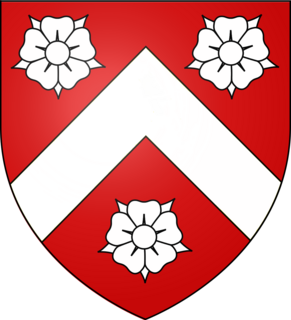 W
WSir Nicholas Wadham of Merryfield in the parish of Ilton, Somerset and Edge in the parish of Branscombe, Devon was the grandfather of Nicholas Wadham (1531–1609), posthumous co-founder of Wadham College, Oxford whose wife Dorothy Wadham outlived him and, in her advanced old age, saw the project through to completion.
 W
WAdmiral Sir William Wynter was an admiral and principal officer of the Council of the Marine under Queen Elizabeth I of England and served the crown during the Anglo-Spanish War (1585–1604).